 |
| October 09, 2012 | Volume 08 Issue 38 |
Designfax weekly eMagazine
Archives
Partners
Manufacturing Center
Product Spotlight
Modern Applications News
Metalworking Ideas For
Today's Job Shops
Tooling and Production
Strategies for large
metalworking plants
Recent design updates and selection considerations for high-temperature and cryogenic aerospace sensors
By Margie Mattingly, PCB Piezotronics
Accelerometers and pressure sensors for measurement in extreme environments require special consideration during design and manufacturing processes. Specialized applications frequently require the use of a single sensor model, which must be capable of operating over significantly wider temperature ranges, for example, -420 to 1,200 degrees F (-251 to 649 degrees C), while providing high accuracy, stability, and reliability (see Figure 1).
Typical applications for high-temperature aerospace sensors include measurement on gas turbine engines both in-flight and in test cells, as well as rocket motors and thruster assemblies. The same sensor might be required to withstand radiation and be used in monitoring vibration inside a nuclear power plant or on a space vehicle, or the cryogenic conditions of liquid propellants. These environments present a multitude of measurement challenges.
Materials and construction must be optimized, not only to enhance high-temperature performance, but also to allow operation in the presence of gamma and neutron radiation without degradation.
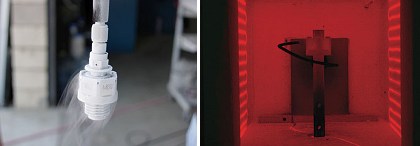
Figure 1. Temperature extremes with piezoelectric sensors. Photo on left shows a high-temp accelerometer on stinger test in thermal chamber at 1,200 degrees F (649 degrees C). Photo on right shows a cryogenic pressure sensor after soak in liquid hydrogen at -420 degrees F (-251 degrees C).
Material selection
Piezoelectric sensors are made from both natural and ferroelectric ceramic crystals. The choice of crystal depends on environmental and performance requirements. Each material has unique features and advantages that characterize its performance in various applications. Natural crystals tend to provide the highest temperature ranges and the lowest pyroelectric outputs. However, ferroelectrics ceramics offer extended frequency ranges and smaller sizes for equivalent charge output (see Figure 2).
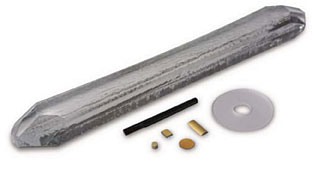
Figure 2. Examples of quartz, tourmaline, and ceramics.
Single, natural crystals, such as quartz or tourmaline, are inherently piezoelectric. Most natural materials are single crystals grown in laboratories rather than mined, resulting in consistent quality with reduced risk of supply. In addition, the man-made aspect of a "natural crystal" enables development of new, higher performance variations.
Ferroelectrics ceramic materials, on the other hand, are not inherently piezoelectric. A ceramic is composed of many crystals in random orientation. For the ceramic to become piezoelectric, the dipoles must be aligned. The alignment/polarization process involves applying a high voltage to the material to align polar regions within the ferroelectrics ceramic element. This process is known as "poling" and is shown pictorially in Figure 3.
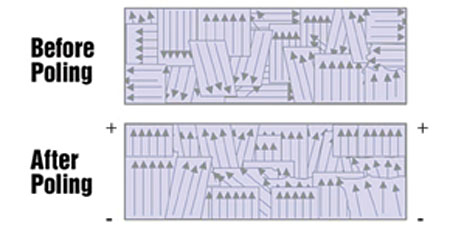
Figure 3. Poling aligns polar regions within the ferroelectrics ceramic element.
Ferroelectric ceramics exhibit significantly higher sensitivity or charge output per imposed unit force. The most common material, bismuth titanate, has an output 10 times the most common high-temperature natural crystal, tourmaline. Bismuth titanate can be used to temperatures as high as 950 degrees F (510 degrees C). Various compounds may be added to the ceramic material to alter sensor characteristics, but high-temperature ranges come at the expense of sensitivity.
A natural single-crystal material can be employed in either shear or compression mode. In compression mode, the material creates an electric charge in the same direction as the applied force. Lead zirconate titanate (PZT) is a ceramic material that is widely used in temperature environments as high as 550 degrees F (288 degrees C). In shear mode, the material creates a charge in the direction perpendicular to the applied force. PZT can be designed into sensors using both shear and compression mode, but is most efficient in the shear since it has a higher charge output and upper temperature range. Typically, shear-mode configurations are more efficient than compression because there is greater bandwidth and higher output with smaller size. In addition, since the required preload force that holds the crystal in place is perpendicular to the polarization axis, a shear design has extremely stable output over time. This enables extensive design flexibility and performance optimization (see Figure 4).
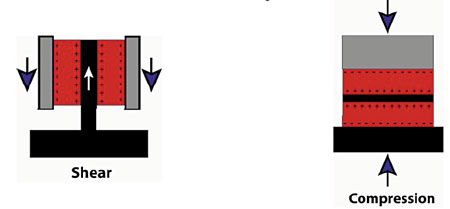
Figure 4. PZT can be designed into sensors using both shear and compression mode.
There are numerous temperatures, bandwidth, mounting, and other tradeoffs that must be considered in high-temperature applications. Temperature effects exist beyond the limitation of the operating environment. Temperature changes may produce extraneous outputs and may change the sensitivity and other parameters. Piezoelectric sensors cannot produce an output in response to a constant temperature, as they cannot produce an output in response to a constant input; they are self-generating. They can produce an output in response to a change in temperature.
The piezoelectric element itself is often pyroelectric; that is, it generates an output in response to temperature. In addition, temperature or temperature gradients may change the pre-load stress on the element because of thermal expansion. Temperature change inside a sensor, where output would be affected, is relatively slow due to the thermal transfer. Therefore, thermal outputs are at low frequencies where they are attenuated by the low frequency of the system. For this reason, thermal output is not usually a problem. Sometimes piezoelectric sensors can show sharp spikes in their output after a large temperature change; this can be related to electrostatic surface discharge of pyroelectric fields. Spikes that continue after a pyroelectric discharge can be related not only to the piezoelectric material but to the design of the individual components and processing of the sensor.
A design that utilizes ferroelectrics ceramics material in compression mode will have a greater pyroelectric output than that of a piezoelectric shear design or one using a natural crystal. This is because of two effects:
- In compression mode accelerometers, piezoelectric material is directly coupled to the environment through the base of the sensor.
- The ferroelectric material is sensitive to uniform temperature changes on those surfaces perpendicular to the axis of polarization.
However, pyroelectric output is a very low-frequency phenomenon that is typically well below frequency ranges of interest and can be avoided by the use of high-pass filtering within measurement system electronics.
Challenges
The maximum operation temperature of sensors is controlled by two design challenges. First is a property of the piezoelectric material alone and is termed the "Curie" temperature in piezoceramics, or "twinning" temperature in natural materials. This is the temperature at which the material loses its piezoelectric properties.
The second design challenge is a sensor's insulation resistance, which significantly decreases with temperature. A low insulation resistance charge amplifier and charge converters must be specifically designed to operate with sensors having low insulation resistance values. If the charge output is being measured, the frequency response will not be affected, but the low frequency noise will tend to increase. And some charge measuring equipment will not tolerate low input resistance and will clip the output signal. Ordinarily, the leakage resistance of a sensor is understood and the appropriate signal conditioning is used, thus there will be no noticeable effects.
Whenever a sensor is exposed to temperature changes, other parameters such as sensitivity and sensor capacitance also change. Changes should be predictable and repeatable. However, they are influenced not only by the crystal material, but with each component and every process associated with building the sensor. Manufacturers should test every high-temperature sensor at its maximum operating temperature in order to ensure consistency and quality.
Successful measurements
Successful high-temperature measurements require more that just good sensor design. Cabling and electrical connections are critical to the acquisition of good-quality data. A loose connector can result in the generation of a high-level, low-frequency signal, unrelated to the measurement. Over time, reliability of connectors can degrade at temperatures over 900 degrees F (482 degrees C) due to oxide formation on pin-to-socket contacts and potential loss of pin retention. The result can show up as a roll-off in the output of the sensor at higher frequencies.
Sensors designed for temperatures up to 1,200 degrees F (649 degrees C) are therefore fitted with integral cables, which also are mechanically isolated from the seismic system to avoid base and cable strain effects. Cables provided might use magnesium oxide or silicone dioxide insulation. The later is preferred, since it is non-hydroscopic and exhibits excellent high-temperature electrical characteristics. Figures 5 and 6 show examples of removable and attached cables.
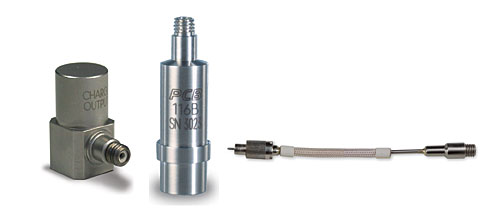
Figure 5. Accelerometer and pressure sensor with removable cable can handle up to 900 degrees F (482 degrees C).

Figure 6. Accelerometer and pressure sensor with attached cable can handle up to 1,200 degrees F (649 degrees C).
Careful selection of cable material and the use of a protective over-braid covering facilitates ease of handling and allows bend forming during installation while maintaining cable integrity. The braid provides "flex" to rigid cables and protects them from getting nicked or damaged. Cables should not be bent under 2.5 times the diameter of the cable, because it may damage internal insulation or affect dielectric properties. Cables on accelerometers should be clamped at approximately 8-in. (20-cm) intervals to prevent excessive flexing during vibration. It's important to provide clearance between cables and other components on the structure to prevent abrasion during vibration.
An accelerometer must be coupled to the surface it is measuring. As a result, bending of the structure or mounting bracket can cause distortion, producing unwanted output called base-strain sensitivity. If brackets must be used, care must be taken to avoid introducing dynamic response problems due to bracket resonances within or near the operational frequency range. A thorough understanding to the modes of mounting brackets and adaptors is important for good data, and it must be verified that engine resonance, bracket resonances, and sensor resonances do not overlap. Figure 7 shows a typical bracket accelerometer.
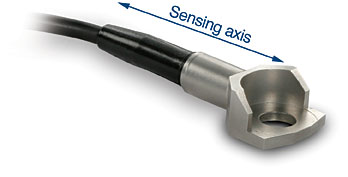
Figure 7. Bracket-mount accelerometer.
Piezoelectric sensors will operate normally when subjected to radiation environments. Pyroelectric outputs will be produced when transient radiation produces significant temperature change, but this is no greater than that produced within the standard temperature range. The magnitude of pyroelectric output depends on the type of piezoelectric ceramic used as well as the design. There should only be small errors produced as a result of temperature changes present in nuclear shock-and-vibration applications typical as a result of Gamma radiation. Neutron radiation could cause a change to the molecular structure, but only at severe extraordinary levels. Adverse reactions to radiation include a reduction of piezoelectric material output and deterioration of various materials that are intolerant to radiation, such as Teflon. Generally, higher temperature crystals are more resistant to the effects of radiation.
High-temperature sensor designs are driven mainly by the purpose for which they are used. In test and measurement applications, single-ended designs are used to minimize mass and size. Because of the wide array of test and measurement environments and associated conditions, high-temperature sensors feature numerous mounting and cable/connector configurations. With a single-ended system, the accelerometer has an inherent capacitance between the case and the signal side of the crystal. It would normally be susceptible to electrostatic pickup without the use of an insulating base.
A general category of high temperature is intended for use in permanently mounted conditions monitoring applications. This type of accelerometer is often referred to as a "bill of material" or OEM sensor because it is integrated into a customers product line. These accelerometers are almost exclusively designed for each application. Unlike their test and measurement counterparts, the housings of these sensors are almost always electrically isolated from the measurement circuit, and the charge output of the sensor is differential. Differential signal output is used where the capacitance balance between signals is important, since the structure it is mounted to is used as an electrical ground return. Capacitance balance allows differential charge amplifiers to distinguish between common mode signal (noise) and differential signal, which is the true measure of the dynamic acceleration. Differential output is preferred when signals must be routed through multipin connectors where individual shielding of conductors is not feasible. A typical monitoring accelerometer is shown in Figure 8.
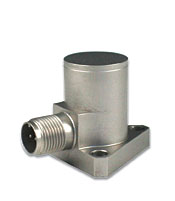
Figure 8. Differential accelerometer for turbine engine monitoring handles up to 900 degrees F (482 degrees C).
Conclusion
Whether used in aircraft engines, space vehicles, or power-generation stations, these sensors must provide high levels of accuracy, stability, and reliability. Therefore, these instruments used in extreme environments, such as cryogens and high temperature, require special consideration during the design and manufacturing process.
Want more information? Click below.
Published October 2012
Rate this article
View our terms of use and privacy policy
